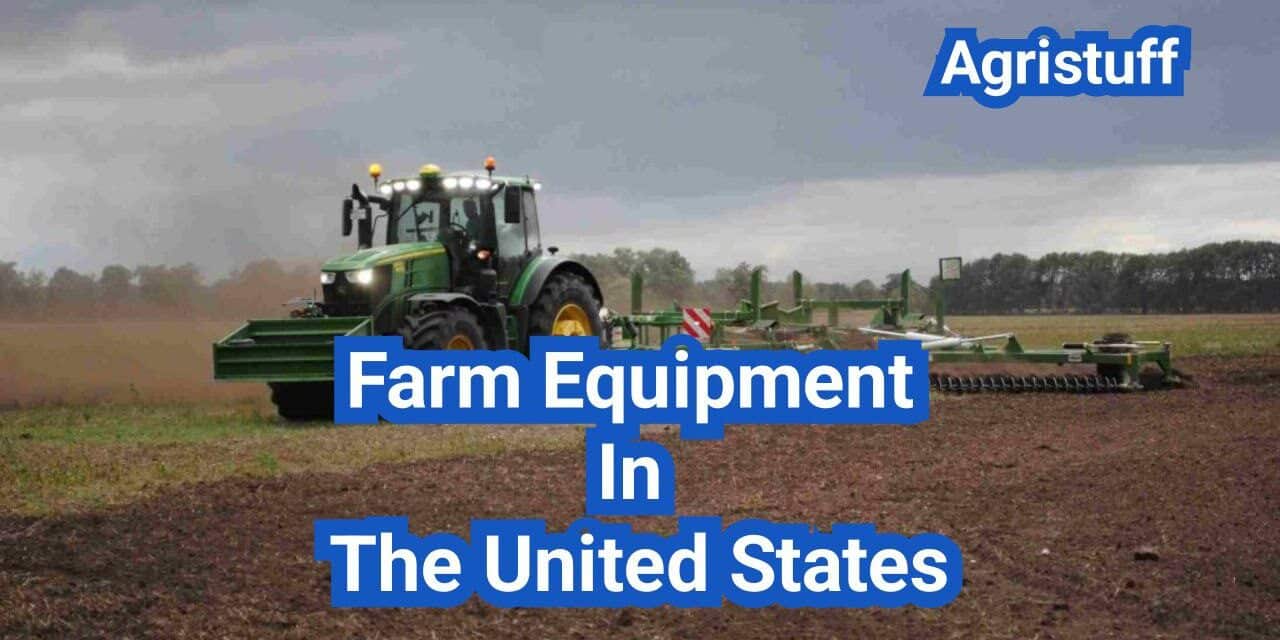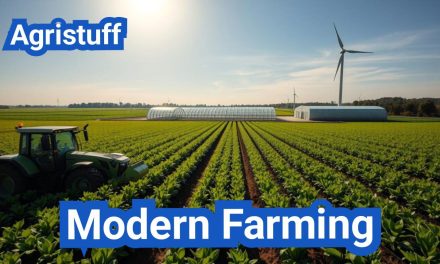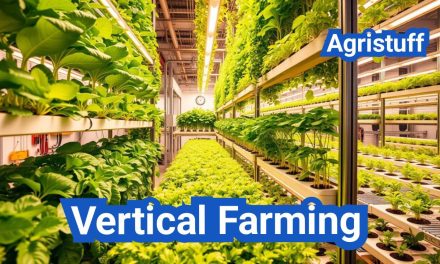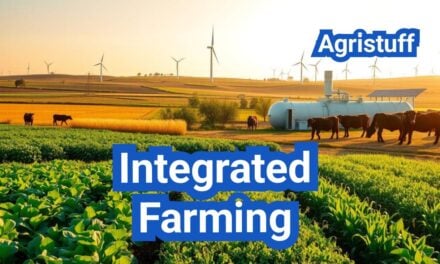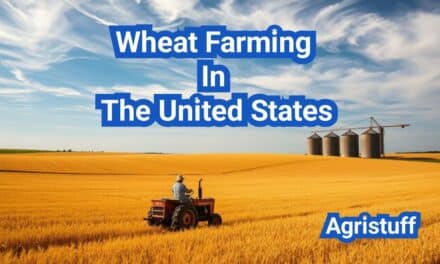The agricultural sector is a vital part of the United States economy, with agricultural machinery playing a crucial role in its success.
Leading manufacturers like John Deere, Case IH, and New Holland provide a range of farm equipment that cater to the diverse needs of the agricultural industry.
The importance of farm equipment cannot be overstated, as it directly impacts the productivity and efficiency of farming operations across the United States.
Key Takeaways
- The agricultural sector is a cornerstone of the US economy.
- Farm equipment In The United States plays a crucial role in the success of the agricultural sector.
- Leading manufacturers provide a range of agricultural machinery.
- The importance of farm equipment lies in its impact on productivity and efficiency.
- The US farming industry relies heavily on advanced farm equipment.
The Current State of American Farm Equipment
The landscape of American farm equipment is diverse, reflecting the varied needs of different farming operations across the country. Modern farming relies on a range of equipment categories to efficiently manage crops and livestock.
Key Equipment Categories for Modern Farming
Farm equipment can be broadly categorized into several key areas: tractors, tillage equipment, planting equipment, harvesting machinery, and irrigation systems. Tractors, for instance, are versatile machines used for various tasks, from plowing fields to powering other equipment.
How Equipment Needs Vary by Farm Size and Type
The specific equipment needs of a farm are largely determined by its size and type. Small farms, for example, may require more compact or specialized equipment, while large commercial operations need heavy-duty machinery capable of handling extensive acreage.
Small Farm Requirements
Small farms often necessitate equipment that is versatile, compact, and cost-effective. Tractors with lower horsepower, smaller tillage tools, and manual or semi-automatic planting equipment are common. These farms may also benefit from used or refurbished equipment to manage costs.
Commercial Operation Necessities
Commercial farming operations, on the other hand, require high-capacity equipment to manage large areas efficiently. This includes high-horsepower tractors, wide-cut tillage tools, precision planting equipment, and advanced harvesting machinery. Such operations often invest in the latest technology to maximize productivity and reduce labor costs.
How to Assess Your Farm’s Equipment Needs

Understanding the specific needs of your farm is crucial for selecting the right equipment. This process involves a comprehensive evaluation of your farm’s operations to determine the most suitable machinery.
Conducting a Farm Operation Analysis
A thorough farm operation analysis is the foundation of assessing equipment needs. This involves examining your farm’s size, crop types, and specific tasks required for each crop cycle. For instance, a farm growing corn and soybeans will have different equipment needs compared to one growing specialty crops like berries.
Creating an Equipment Priority List
Once you’ve analyzed your farm operations, create a list prioritizing the equipment you need. This list should be based on the critical tasks and operations identified during your analysis. Essential equipment should be distinguished from optional machinery to help guide your purchasing decisions.
Budgeting for Essential vs. Optional Equipment
Budgeting is a critical step in acquiring farm equipment. Differentiate between essential and optional equipment to allocate your budget effectively. Consider the cost-benefit analysis of new versus used equipment and explore financing options.
| Equipment Type | Priority Level | Budget Allocation |
|---|---|---|
| Tractors | High | 40% |
| Planters | High | 30% |
| Harvesters | Medium | 20% |
| Irrigation Systems | Low | 10% |
Selecting the Right Tractor for Your Operation
Choosing the right tractor is crucial for efficient farm operations. The ideal tractor can significantly enhance productivity and reduce operational costs.
Step-by-Step Tractor Selection Process
To select the right tractor, farmers should follow a systematic approach:
- Assess farm size and terrain
- Identify primary tasks (plowing, tilling, hauling)
- Consider compatibility with existing equipment
- Evaluate budget constraints
Matching Horsepower to Farm Tasks
The horsepower of a tractor should be matched to the tasks it will perform. Higher horsepower tractors are suitable for heavy-duty tasks like deep tillage, while lower horsepower tractors are ideal for lighter tasks such as mowing.
Evaluating Transmission Options
Transmission type significantly affects tractor performance. The main options are:
Standard Manual Transmissions
Manual transmissions offer control and are typically more affordable. They require operator skill to shift gears smoothly.
Hydrostatic and CVT Options
Hydrostatic transmissions provide smooth operation and are ideal for tasks requiring frequent speed changes. Continuously Variable Transmissions (CVT) offer infinite gear ratios within a range, optimizing engine performance.
| Transmission Type | Key Features | Ideal Tasks |
|---|---|---|
| Standard Manual | Control, Cost-effective | Heavy-duty tasks, Plowing |
| Hydrostatic | Smooth operation, Easy to use | Loader work, Frequent speed changes |
| CVT | Infinite gear ratios, Optimizes engine performance | Varied tasks, Precision farming |
By carefully evaluating these factors, farmers can select a tractor that meets their operational needs and enhances overall efficiency.
How to Choose Tillage Equipment for Different Soil Types
Choosing the right tillage equipment is crucial and depends heavily on the type of soil you’re working with. Different soil types require specific tillage tools to optimize farming results and minimize soil disturbance.
Primary Tillage Tool Selection Guide
Primary tillage tools are used to break up the soil to a significant depth. The choice of these tools depends on the soil type. For example, in heavy clay soils, a moldboard plow is often used due to its ability to turn over the soil effectively.
In contrast, for lighter soils like sandy loams, a chisel plow might be more appropriate as it breaks up the soil without turning it over, reducing the risk of soil erosion.
Secondary Tillage Implementation Steps
Secondary tillage is used to refine the soil after primary tillage, preparing it for planting. This involves using tools like disk harrows or field cultivators to further break down clods and level the soil.
Conservation Tillage Methods and Equipment
Conservation tillage aims to minimize soil disturbance, preserving soil health and reducing erosion. Techniques include no-till or reduced-till farming, using equipment like no-till drills or strip-till units.
| Soil Type | Primary Tillage Tool | Conservation Tillage Method |
|---|---|---|
| Heavy Clay | Moldboard Plow | No-Till |
| Sandy Loam | Chisel Plow | Strip-Till |
| Silt Loam | Disk Plow | Reduced-Till |
Planting Equipment Selection and Calibration

Modern farming relies heavily on the proper selection and calibration of planting equipment. This crucial step can significantly impact crop yields and overall farm efficiency.
Row Crop Planter Setup Instructions
Setting up a row crop planter involves several key steps. First, ensure that the planter is properly aligned and that all row units are functioning correctly. Adjust the planting depth and seed spacing according to the specific crop requirements. Regularly inspect and maintain the planter to prevent issues during operation.
Calibrating Seed Drills for Optimal Performance
Calibrating seed drills is essential for achieving uniform seed distribution. Start by checking the drill’s metering system and make adjustments as necessary. Monitor the seed population and adjust the drill’s settings to match the desired planting rate. Regular calibration ensures optimal performance and reduces waste.
Implementing Precision Planting Technology
Precision planting technology offers advanced features such as GPS guidance and variable rate planting. Integrate these technologies with your planting equipment to enhance accuracy and efficiency. This can lead to improved crop yields and reduced input costs.
Farm Equipment in the United States: Regional Selection Guide
Regional differences in climate, soil, and crops necessitate a tailored approach to farm equipment selection. The United States encompasses a wide range of agricultural practices, from the grain production in the Midwest to specialty crops on the West Coast.
Equipment Solutions for Midwest Grain Production
The Midwest is known for its extensive grain production, requiring large-scale equipment such as high-capacity combines and planters. High-horsepower tractors are essential for handling the demanding tasks associated with grain farming. Additionally, precision agriculture technology is widely adopted in this region to maximize yield and efficiency.
Southern Agriculture Machinery Requirements
The Southern United States has a diverse agricultural landscape, including cotton, soybeans, and corn. Equipment needs in this region often include cotton pickers and specialized tillage tools to handle the various soil types. Tractors with appropriate horsepower for the local farming operations are also crucial.
West Coast Specialty Equipment Considerations
The West Coast is known for producing a variety of specialty crops, including fruits, nuts, and vegetables. This region requires specialized equipment such as harvesters for crops like almonds and grapes. Precision irrigation systems are also vital due to the dry climate in many areas.
Northeast and Small Farm Equipment Options
The Northeast region is characterized by smaller, often family-owned farms, with a focus on diverse crops and livestock. Equipment needs here include versatile tractors and implements suitable for smaller acreage. Three-point hitch systems are commonly used for their adaptability to various tasks.
How to Properly Operate Harvesting Equipment

To get the most out of your harvesting equipment, it’s vital to understand how to operate it correctly. Proper operation not only maximizes efficiency but also reduces losses during the harvest season. Harvesting equipment, particularly combine harvesters, are complex machines that require a good understanding of their functionalities and capabilities.
Combine Harvester Operation Techniques
Operating a combine harvester effectively involves more than just driving the machine. It requires a deep understanding of how to adjust its various components to suit different crop conditions. Pre-harvest checks are crucial, including ensuring that all parts are in good working condition and that the machine is properly calibrated for the specific crop being harvested.
Monitoring crop conditions during harvest is also important. This includes adjusting the combine’s settings in real-time to optimize performance and minimize losses.
Adjusting Settings for Different Crops
Different crops have unique requirements when it comes to harvesting. For instance, crops like wheat and soybeans require different settings compared to corn or rice. Understanding these differences and knowing how to adjust the combine harvester’s settings accordingly is key to efficient harvesting.
- Adjusting the threshing and separating settings based on crop type and moisture content.
- Setting the correct header height and configuration for the specific crop.
- Calibrating the cleaning system to minimize grain loss.
Maximizing Efficiency During Harvest
Maximizing efficiency during harvest involves several strategies, including reducing field losses and optimizing throughput.
Reducing Field Losses | Farm Equipment In The United States
Field losses can significantly impact the overall yield and profitability of a harvest. To minimize these losses, it’s essential to:
- Regularly check and adjust the combine’s settings.
- Monitor crop flow and machine performance.
- Use technology such as yield monitors to identify areas of loss.
Optimizing Throughput | Farm Equipment In The United States
Optimizing throughput involves ensuring that the combine harvester operates at its maximum capacity without compromising grain quality. This can be achieved by:
- Maintaining a consistent ground speed.
- Adjusting the threshing and separating settings for optimal performance.
- Ensuring proper machine maintenance to avoid breakdowns.
Implementing a Preventive Maintenance Program

To maximize farm equipment’s operational life, implementing a preventive maintenance program is essential. Regular maintenance not only prolongs the life of the equipment but also prevents unexpected breakdowns that can lead to costly repairs and downtime.
Daily Equipment Inspection Checklist
A daily inspection is crucial for identifying potential issues before they become major problems. The checklist should include:
- Checking fluid levels (engine oil, hydraulic fluid, coolant)
- Inspecting tires for wear and proper inflation
- Examining belts and hoses for signs of wear
- Ensuring all lights and signals are functioning
Seasonal Maintenance Schedules
Seasonal maintenance is vital for preparing equipment for the demands of different farming seasons. This includes:
- Spring: Check and replace filters, inspect and clean equipment, and ensure all systems are functioning properly.
- Summer: Monitor equipment temperature, check for signs of overheating, and maintain fluid levels.
- Fall: Prepare equipment for harvest, inspect cutting and threshing components, and perform necessary repairs.
- Winter: Store equipment properly, perform thorough inspections, and address any issues before the next season.
Fluid and Filter Change Procedures
Regularly changing fluids and filters is a critical aspect of preventive maintenance. This includes:
- Engine oil and filters: Change according to the manufacturer’s schedule.
- Hydraulic fluid: Check for contamination and change as needed.
- Air filters: Clean or replace to ensure optimal engine performance.
Lubrication Points and Practices | Farm Equipment In The United States
Proper lubrication is essential for reducing wear on moving parts. Identify all lubrication points on your equipment and follow the manufacturer’s recommended lubrication schedule. Use the correct type and amount of lubricant to ensure optimal performance and longevity.
Troubleshooting Common Equipment Problems
Farm equipment troubleshooting is essential for minimizing downtime and maximizing productivity on American farms. By identifying and resolving issues promptly, farmers can avoid costly repairs and maintain operational efficiency.
Engine and Power System Diagnostics
Engine problems can significantly impact farm operations. Common issues include overheating, low oil pressure, and poor fuel efficiency. To diagnose engine problems, start by checking the basics: oil levels, coolant levels, and air filter condition. Use diagnostic tools to scan for error codes and monitor engine performance.
Hydraulic System Troubleshooting Steps
Hydraulic system failures can halt farm operations. Common issues include leaks, low pressure, and contamination. To troubleshoot, inspect hydraulic lines for damage, check fluid levels, and look for signs of wear on hydraulic components. Regular maintenance, such as changing hydraulic filters and fluid, can prevent many issues.
Electrical System Problem Resolution | Farm Equipment In The United States
Electrical system problems can cause a range of issues, from faulty lighting to equipment failure. To resolve these problems, start by checking fuses and circuit breakers. Inspect wiring for damage or corrosion, and use a multimeter to test voltage and continuity. Regularly cleaning electrical connections and ensuring proper wiring can help prevent many electrical issues.
By following these troubleshooting steps, farmers can quickly identify and resolve common equipment problems, minimizing downtime and maintaining productivity.
How to Finance Farm Equipment Effectively

Effective farm equipment financing is crucial for the productivity and profitability of agricultural businesses. Farmers have several options to consider when seeking to acquire new or used equipment.
Comparing Loan Options and Terms
When exploring loan options, farmers should compare interest rates, repayment terms, and any associated fees. Government-backed loans, such as those offered by the USDA, may offer more favorable terms than conventional loans. It’s essential to review and understand the total cost of the loan over its lifespan.
Evaluating Lease vs. Purchase Decisions
Deciding whether to lease or purchase farm equipment depends on several factors, including the equipment’s expected lifespan, usage, and the farm’s financial situation. Leasing can provide tax benefits and reduce upfront costs, while purchasing may offer long-term savings.
Utilizing Tax Incentives and Depreciation | Farm Equipment In The United States
Farmers can take advantage of tax incentives such as Section 179 deductions, which allow for the full purchase price of qualifying equipment to be deducted in the year of purchase. Understanding depreciation rules can also help in making informed decisions about equipment acquisition.
Accessing USDA Programs and Grants
The USDA offers various programs and grants to support farmers in acquiring equipment, especially for conservation practices and beginning farmers. Exploring these opportunities can provide significant financial assistance.
By carefully evaluating these financing options and incentives, farmers can make informed decisions that support the long-term viability of their operations.
Implementing Precision Agriculture Systems

Precision agriculture is revolutionizing farming practices across the United States. By leveraging advanced technologies such as GPS guidance, variable rate applications, and farm management software, farmers can significantly enhance their operational efficiency and productivity.
Installing and Calibrating GPS Guidance
The first step in implementing precision agriculture is installing and calibrating GPS guidance systems. This technology enables farmers to navigate their fields with high accuracy, reducing overlap and ensuring that every area is cultivated appropriately. Calibration involves adjusting the GPS system to match the specific equipment and field conditions.
Setting Up Variable Rate Applications | Farm Equipment In The United States
Variable rate applications allow farmers to apply inputs such as fertilizers and seeds at varying rates across different parts of the field. This is achieved by integrating GPS data with application equipment, ensuring that resources are used more efficiently. Setting up variable rate applications involves creating detailed maps of the field and configuring the equipment to adjust application rates accordingly.
Integrating Equipment with Farm Management Software
Farm management software plays a crucial role in precision agriculture by providing a centralized platform for data collection, analysis, and decision-making. Integrating equipment with this software enables real-time data transfer, allowing farmers to monitor and adjust their operations more effectively.
| Precision Agriculture Component | Function | Benefits |
|---|---|---|
| GPS Guidance | Accurate navigation and reduced overlap | Increased efficiency, reduced costs |
| Variable Rate Applications | Optimized input application | Resource efficiency, improved yields |
| Farm Management Software | Data collection and analysis | Informed decision-making, enhanced productivity |
Equipment Safety Protocols and Training

Implementing robust equipment safety measures is essential for safeguarding farm workers and optimizing agricultural productivity. A comprehensive approach to equipment safety involves several key components.
Developing an Equipment Safety Program | Farm Equipment In The United States
A well-structured safety program is the foundation of equipment safety. This involves:
- Conducting regular risk assessments
- Establishing clear safety guidelines
- Providing personal protective equipment (PPE)
Training Operators on Safe Practices | Farm Equipment In The United States
Proper training is crucial for ensuring that operators can safely and effectively use farm equipment. This includes:
- Hands-on training sessions
- Regular refresher courses
- Simulated emergency scenario training
Creating Emergency Response Procedures
Despite best efforts, accidents can still occur. Having a well-planned emergency response procedure in place is vital.
Accident Prevention Measures | Farm Equipment In The United States
Preventing accidents is always preferable to responding to them. Measures include regular equipment maintenance and operator vigilance.
First Aid and Emergency Contacts | Farm Equipment In The United States
Ensuring that first aid kits are readily available and that all workers know who to contact in an emergency is critical.
How to Evaluate Used Farm Equipment
To ensure a wise investment, it’s vital to assess used farm equipment carefully. Evaluating the condition and performance of machinery can help farmers make informed decisions and avoid costly surprises down the line.
Inspection Checklist for Used Machinery | Farm Equipment In The United States
A thorough inspection is the foundation of evaluating used farm equipment. Start by examining the overall condition, looking for signs of wear, rust, or damage. Check for any missing parts or signs of repair. Create a detailed checklist that includes the equipment’s operational status, maintenance history, and any visible damage.
Assessing Wear Points and Component Life
Identify critical wear points specific to the equipment type, such as tires, blades, or hydraulic components. Assess the remaining life of these components and factor in the cost of replacement if necessary. Consider the equipment’s age, usage hours, and maintenance records to estimate its remaining useful life.
Negotiating Price Based on Condition | Farm Equipment In The United States
Armed with the inspection results, you can negotiate the price more effectively. Compare the equipment’s condition to its original price and consider the cost of needed repairs. Use this information to make a data-driven offer that reflects the equipment’s true value.
Comparing Top Equipment Brands for Your Needs
Farmers today have a wide range of equipment brands to choose from, each offering unique features and benefits. The choice of farm equipment brand can significantly impact your farm’s productivity and efficiency.
When evaluating farm equipment brands, several key players stand out in the industry. John Deere and Case IH are two of the most recognized names, known for their advanced technology and comprehensive product lines.
John Deere vs. Case IH Feature Comparison
Both John Deere and Case IH offer a range of tractors and farming equipment with advanced features. For instance, John Deere’s AutoTrac system allows for precise guidance, while Case IH’s Advanced Farming Systems provide detailed data analysis for better decision-making. According to a recent industry report, “The adoption of precision agriculture technologies, such as those offered by John Deere and Case IH, has shown to increase crop yields by up to 15%.”
“The right equipment can make all the difference in farming. Investing in quality brands like John Deere and Case IH is crucial for long-term success.” – Industry Expert
New Holland and Kubota Equipment Analysis
New Holland is known for its innovative designs and fuel-efficient machinery, while Kubota offers a range of compact equipment ideal for smaller farming operations. Both brands have their strengths, with New Holland’s PL series offering high productivity and Kubota’s tractor line providing versatility.
- New Holland’s focus on sustainability
- Kubota’s compact equipment solutions
Specialty Manufacturers for Niche Operations
For farmers with specific needs, such as orchard or vineyard management, specialty manufacturers offer tailored solutions. These brands provide equipment designed to meet the unique challenges of niche farming operations, ensuring that farmers can maintain productivity and efficiency.
By comparing these top equipment brands, farmers can make informed decisions that best suit their operational needs and enhance their overall productivity.
Adapting to Emerging Equipment Technologies
The farm equipment industry is on the cusp of a revolution, driven by emerging technologies that promise to transform agricultural practices. These advancements are not only improving efficiency and productivity but also addressing environmental concerns and labor shortages.
Implementing Autonomous Equipment Solutions
Autonomous farm equipment is becoming increasingly prevalent, offering significant benefits in terms of labor savings and operational efficiency. Autonomous tractors and drones are being used for tasks such as planting, spraying, and monitoring crop health. Farmers can implement autonomous solutions by integrating GPS guidance systems and investing in compatible equipment.
Transitioning to Electric and Hybrid Machinery
The shift towards electric and hybrid farm machinery is gaining momentum, driven by the need to reduce emissions and operating costs. Electric tractors and other equipment offer quieter operation and lower maintenance costs. Farmers should consider the long-term benefits and potential incentives when evaluating the transition to electric or hybrid machinery.
Utilizing Equipment Data for Decision Making
Modern farm equipment generates vast amounts of data, which can be used to inform decision-making and optimize farm operations. By leveraging equipment data analytics, farmers can gain insights into soil health, crop yields, and equipment performance. This data-driven approach enables farmers to make more informed decisions and improve overall efficiency.
Maximizing Your Farm Equipment Investment
Maximizing the return on investment in farm equipment involves proper selection, maintenance, and operation of machinery. By understanding the current state of American farm equipment and assessing your farm’s specific needs, you can make informed decisions that enhance efficiency and productivity.
Effective farm equipment investment requires a thorough analysis of your operation, from selecting the right tractor to implementing precision agriculture systems. Regular maintenance and proper operation of equipment are crucial to extending their lifespan and maximizing efficiency.
By adopting best practices and staying informed about emerging technologies, farmers can optimize their equipment usage, reduce costs, and improve overall farm performance. Whether you’re managing a small farm or a large agricultural operation, maximizing your farm equipment investment is key to achieving long-term success.
Investing in the right equipment and maintaining it properly will lead to increased productivity and better returns on your farm equipment investment, ultimately contributing to the overall success of your agricultural endeavors.
FAQ
What are the primary categories of farm equipment used in modern farming?
The primary categories of farm equipment include tractors, tillage equipment, planting equipment, harvesting equipment, and precision agriculture systems.
How do I assess my farm’s equipment needs?
To assess your farm’s equipment needs, conduct a farm operation analysis, create an equipment priority list, and budget for essential versus optional equipment.
What factors should I consider when selecting a tractor for my farm?
When selecting a tractor, consider the step-by-step tractor selection process, matching horsepower to farm tasks, and evaluating transmission options.
How do I choose the right tillage equipment for my soil type?
To choose the right tillage equipment, consider primary tillage tool selection, secondary tillage implementation, and conservation tillage methods.
What are the key considerations for planting equipment selection and calibration?
Key considerations for planting equipment include row crop planter setup, calibrating seed drills, and implementing precision planting technology.
How do regional factors impact farm equipment selection?
Regional factors such as climate, soil type, and crop selection impact farm equipment needs, with different regions requiring specialized equipment.
What are the best practices for operating harvesting equipment?
Best practices for operating harvesting equipment include combine harvester operation techniques, adjusting settings for different crops, and maximizing efficiency during harvest.
Why is preventive maintenance important for farm equipment?
Preventive maintenance is crucial for extending equipment lifespan, reducing downtime, and improving overall farm productivity.
How do I troubleshoot common equipment problems?
To troubleshoot common equipment problems, use engine and power system diagnostics, hydraulic system troubleshooting, and electrical system problem resolution.
What are the financing options available for farm equipment?
Financing options for farm equipment include comparing loan options, evaluating lease versus purchase decisions, and utilizing tax incentives and USDA programs.
How can I implement precision agriculture systems on my farm?
To implement precision agriculture systems, install and calibrate GPS guidance, set up variable rate applications, and integrate equipment with farm management software.
Why is equipment safety training important?
Equipment safety training is essential for preventing accidents, reducing liability, and ensuring a safe working environment.
How do I evaluate used farm equipment?
To evaluate used farm equipment, create an inspection checklist, assess wear points and component life, and negotiate price based on condition.
What are the emerging technologies in farm equipment?
Emerging technologies in farm equipment include autonomous equipment solutions, electric and hybrid machinery, and utilizing equipment data for decision-making.
Conclusion of: Farm Equipment In The United States
Farm Equipment In The United States: Why Mechanization Matters
Farm Equipment In The United States is a cornerstone of productivity because U.S. farms are large, highly specialized, and often operate within narrow planting and harvest windows. With fewer people working more acres than ever, mechanization turns time-sensitive fieldwork into predictable workflows, letting farmers plant, protect, and harvest crops efficiently while keeping costs under control.
This long-term shift toward higher output per worker explains why Farm Equipment In The United States keeps advancing in power, comfort, and precision year after year. USDA ERS farming and income statistics
Farm Equipment In The United States Market Snapshot (2025)
The market for Farm Equipment In The United States rises and falls with farm profitability, interest rates, and replacement cycles. After several strong years of buying, many producers are now leaning on repairs or the used market unless new machines offer clear gains in fuel savings, labor reduction, or precision. Industry sales reports in 2025 show softer demand in several tractor horsepower classes and combines compared with 2024, signaling a more cautious investment mood.
Even so, technology upgrades and regional needs keep the Farm Equipment In The United States market active, especially for equipment that lowers per-acre costs. AEM U.S. ag tractor & combine reports
Tractors: The Power Hub of Farm Equipment In The United States
When most people picture Farm Equipment In The United States, they picture tractors because tractors are the power hub for nearly every field and livestock task. They provide PTO power, hydraulics, and towing for mowing, baling, tillage, planting, and heavy hauling.
U.S. farms typically choose tractors by horsepower band—compact units for chore work and small acreage, row-crop tractors for planting and cultivation, and high-horsepower wheeled or tracked tractors for wide tillage and large seeders. Today’s Farm Equipment In The United States tractor lines also emphasize cab comfort, telematics, and emissions-compliant engines. Case IH tractor families overview
Tillage & Soil Preparation Tools in Farm Equipment In The United States
Soil preparation is still a major use of Farm Equipment In The United States, even as conservation systems spread. Plows, chisel plows, disks, vertical-tillage tools, and subsoilers manage residue, break compaction, and create seedbeds suited to local soils. In many regions, growers are shifting toward reduced-till or no-till to protect structure, cut erosion, and lower fuel use, relying on strip-till rigs and residue managers instead of full inversion.
Choosing the right tillage setup within Farm Equipment In The United States is now as much about soil health and moisture conservation as it is about field finish. USDA NRCS conservation tillage resources
Planting & Seeding Systems in Farm Equipment In The United States
Planting equipment is where Farm Equipment In The United States directly sets yield potential because seed placement determines emergence, stand uniformity, and root development. Row-crop planters place seed at consistent depth and spacing, while air seeders and drills cover large acres quickly for wheat, barley, and cover crops.
U.S. growers increasingly use high-speed meters, downforce control, and section shutoff to reduce skips and overlaps. In no-till systems, heavier frames and sharp openers are essential. All of these advances make modern Farm Equipment In The United States planting systems a profit tool, not just a field tool. USDA NRCS no-till planting equipment guide
Sprayers and Crop-Protection Equipment in Farm Equipment In The United States
Crop protection is another huge lane for Farm Equipment In The United States, especially on large grain and cotton operations where timing and coverage decide weed and disease pressure. Self-propelled and pull-type boom sprayers apply herbicides, fungicides, and foliar nutrients across thousands of acres, while specialty sprayers serve orchards and vineyards.
Precision nozzles, pulse-width modulation, and boom-height control reduce drift and improve rate accuracy. Calibration is critical for performance and compliance, so Farm Equipment In The United States users depend on extension standards before every major spray cycle. Oklahoma State sprayer calibration fact sheet
Irrigation Systems as Farm Equipment In The United States
In irrigated regions, Farm Equipment In The United States includes center pivots, linear moves, drip systems, pumps, filtration, and control panels. Center pivots dominate in parts of the Plains and West because they water large fields efficiently with modest labor.
Many pivots now integrate variable-rate irrigation and soil-moisture sensing so water follows crop need rather than a fixed timer—an increasingly important upgrade as aquifers and allocations tighten. These irrigation tools show that Farm Equipment In The United States is not only about power and acres, but also about precision water stewardship. USDA NRCS Irrigation Guide (PDF)
Harvesting Machines: Combines and Beyond
Harvest is the most time-critical stage, so Farm Equipment In The United States places a premium on combines, headers, grain carts, and logistics. Combines are often the single highest-cost machine on a grain farm, but their capacity reduces crop loss and weather risk when fields must be cleared fast.
Specialty crops rely on dedicated harvesters—cotton pickers in the South, potato and beet harvesters in the Upper Midwest, and nut or grape harvesters in California. With each upgrade, Farm Equipment In The United States harvesting systems aim to raise acres per hour while protecting grain quality. Iowa State harvesting equipment overview
Hay & Forage Gear in Farm Equipment In The United States
Livestock and mixed farms lean heavily on Farm Equipment In The United States forage systems such as mower-conditioners, tedders, rakes, forage choppers, and round or square balers. The core goal is fast drying, minimal leaf loss, and safe, efficient storage. Large-bale systems save labor but demand the right tractor stability and bale-handling attachments to prevent rollovers.
Extension specialists emphasize equipment matching, knotter maintenance, and cautious bale transport. Well-managed forage Farm Equipment In The United States protects feed value and animal performance. Penn State hay bale safety
Livestock & Dairy Equipment Within Farm Equipment In The United States
Farm Equipment In The United States is not only field machinery; it includes feeding, watering, manure handling, and milking systems that drive animal health and labor efficiency. Beef and sheep farms use mixers, feed wagons, squeeze chutes, fencing tools, and pasture equipment.
Dairy farms invest in parlors, vacuum systems, cooling equipment, and sometimes robotic milking units tied to herd-monitoring sensors. Routine checks on liners, pulsators, and vacuum levels are essential for milk quality. These systems show how Farm Equipment In The United States supports both crop and animal agriculture. Penn State dairy facilities & technology
Grain Handling, Storage, and Post-Harvest Equipment
Post-harvest Farm Equipment In The United States includes augers, conveyors, dryers, aeration fans, grain bins, and loader systems that protect crop value after the combine leaves the field. Faster unloading and drying reduce spoilage risk and help farms capture better basis opportunities.
Grain carts, high-capacity augers, and well-designed bin sites are often “harvest multipliers” because they keep combines moving instead of waiting on trucks. Safe bin entry, lockout procedures, and dust management remain crucial parts of Farm Equipment In The United States management. Purdue grain handling and safety resources
Precision Agriculture Attachments in Farm Equipment In The United States
A defining shift in Farm Equipment In The United States is precision agriculture, where GPS guidance, yield monitors, and variable-rate systems turn machines into decision tools. Auto-steer reduces overlap and operator fatigue, while yield mapping identifies which zones are profitable and which need different management. Variable-rate seeding and fertilizer let farms match inputs to soil potential, saving money and improving environmental outcomes.
Precision adoption has expanded steadily in U.S. row crops, making Farm Equipment In The United States as much about data as steel. USDA ERS precision ag adoption summary
Automation, Autonomy, and Electrification Trends
The next wave of Farm Equipment In The United States is automation, including autonomous tractors and robotic implements that address labor scarcity and allow 24/7 fieldwork in short windows. Early commercial autonomous platforms use cameras, radar, and GPS with remote supervision rather than a driver in the cab.
Electrification is also growing, especially in compact and utility tractors where battery torque fits real-world workloads, while hybrids are emerging for mid-size classes. Together, these trends suggest Farm Equipment In The United States will keep moving toward lower labor per acre and higher operating precision. John Deere autonomous equipment
Emissions and Sustainability Standards Shaping Equipment
Farm Equipment In The United States must meet strict nonroad diesel emissions rules, notably EPA Tier 4/Final standards that sharply cut particulate matter and NOx. These regulations pushed widespread use of diesel particulate filters and SCR systems, changing both engine design and daily maintenance routines (including DEF handling).
At the same time, farmers increasingly buy conservation-minded machinery—no-till drills, cover-crop seeders, and precision nutrient tools—to improve soil health and reduce runoff. In practice, Farm Equipment In The United States now supports compliance, sustainability, and profitability at once. EPA nonroad diesel (Tier 4) standards
Maintenance, Parts, and Dealer Support
Reliability is a profit lever, so Farm Equipment In The United States comes with a strong support ecosystem of dealers, parts supply chains, and mobile service trucks. Preventive routines—daily greasing, fluid checks, belt and chain inspection, and sensor cleaning—often matter more than raw horsepower gains. Seasonal storage includes battery care, fuel treatment, rodent prevention, and corrosion checks, especially in cold regions.
PTO shielding and driveline inspections remain critical because many implements still run through PTO power. Smart maintenance keeps Farm Equipment In The United States working when it counts. Penn State PTO safety and maintenance
Ownership Choices: New, Used, Leasing, and Custom Hire
Because Farm Equipment In The United States is capital-intensive, farms often blend ownership strategies. Large grain farms may own core tractors and combines but lease specialty gear, while smaller operations sometimes hire custom operators for planting, spraying, or harvest to avoid tying up cash in machines used only a few weeks per year.
Joint ownership can also reduce cost per acre if partners align on scheduling and repair responsibility. These flexible approaches help farms keep Farm Equipment In The United States aligned with real acres and real margins. Iowa State machinery ownership vs custom hire
Safety, Training, and the Human Factor
Even with high tech, Farm Equipment In The United States is only as safe as its operators. Tractor rollovers, PTO entanglements, and combine servicing accidents remain leading causes of severe farm injuries. Safety best practices emphasize ROPS and seatbelt use, clear lockout/tagout during repairs, good lighting, and communication among crews.
Training should be treated like any field task, because injuries cause far more costly downtime than maintenance ever does. Truly modern Farm Equipment In The United States includes a culture of safe operation. NIOSH tractor rollover prevention (PDF)
Right-to-Repair and Data Ownership Issues
A newer conversation around Farm Equipment In The United States centers on repair access and software control. As machines became more computerized, some brands restricted diagnostics and certain repairs to licensed dealers, raising concerns about downtime and cost. U.S. regulators and several states have pushed right-to-repair momentum in response, and the debate continues in 2025.
Meanwhile, field data generated by equipment—like yield maps and operational logs—has become a valuable farm asset that growers want to own and manage securely. These pressures are shaping how Farm Equipment In The United States is designed, sold, and serviced. FTC press releases on repair policy
Final thought
Farm Equipment In The United States keeps evolving because U.S. agriculture must balance scale, labor shortages, soil health, water limits, and tighter margins all at once. The most successful farms are the ones that match equipment capacity to real acres, stay disciplined on maintenance and safety, and adopt technology only when it clearly reduces costs or raises output.
Whether you manage a small specialty farm or a multi-thousand-acre grain operation, the smartest approach to Farm Equipment In The United States is to view it as a connected system—power, implements, data, timing, and people working together to protect profitability. USDA ARMS farm practices & cost data
Sources & References
- Deere.com
- agriculture.newholland.com/en-us/nar
- Farmequipmentusa
- USDA ERS – Farming and Farm Income statistics
- AEM – U.S. Ag Tractor and Combine Reports
- Oklahoma State Extension – Ground sprayer calibration
- Iowa State Extension – Harvesting equipment and combine economics
- Penn State Extension – Safe hay bale handling
- Penn State Extension – Dairy facilities and technology
- Purdue Extension – Grain handling and harvest safety
- USDA ERS – Precision agriculture adoption
- John Deere – Autonomous farm equipment
- Penn State Extension – PTO safety
- Iowa State Extension – Machinery ownership vs custom hire
- FTC – Repair and competition press releases

